|
Carpets and kilims since their
beginning, were not created just for meeting man's physical needs but also for his psychological
wishes. Religious beliefs and ritual life enrich and develop philosophical thoughts and the soul of man. This influences both the artist and his work in various
ways. Just looking at the motifs and compositions in the carpets and kilims makes this
evident.
The meanings of the motives in Turkish carpet are different depending on the
region. However, generally the motives symbolize religious beliefs,
nobility, power and the other themes described below briefly. The language of carpets and kilims not only indicates the skill of the weaver but also transmits their
messages.
|
|
| Amulet and Evil Eye |
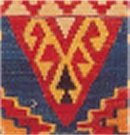 |
It is believed that some people possess a power in their glance which causes harm, injury, misfortune and even death. Evil eyes are various objects that reduce the effect of the evil glance, thus protecting the ones who carry them. "Muska" is a written charm which is believed to have magical and religious power to protect the possessor from dangerous external factors.
|
|
| Bird |
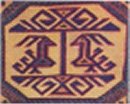 |
The bird motifs seen in Turkish carpets have various meanings. While birds live owls and ravens imply bad luck, doves, pigeons and nightingales are used to symbolize good luck. The bird is the symbol of happiness, joy and love. It stands for power and strenght. It is the imperial symbol of various states founded in Anatolia. The birds also refers to divine messengers and long life. The Anka bird (Phoenix) fighting with the dragon refers to
spring.
|
|
| Burdock |
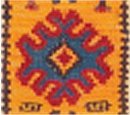 |
Burdock is a plant with burrs which stick to the clothing of people and the hair of animals. It is believed to be capable of warding off the evil eye. On the other hand, the fact that the term "like a burdock" means full of flowers, accounts for the use of this motif on flour bags as a symbol of
abundance.
|
|
| Chest |
 |
This motif in general, symbolizes the trousseau chest of a young girl. Since the objects in this chest is to be used in the husband's house, the expactations and hopes of the young girl are reflected in the pieces she has woven knitted and embroidered.
|
|
| Cross and Hook |
 |
In Turkish carpets hooks and various cross types are used frequently to protect from danger.
|
|
| Dragon |
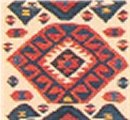
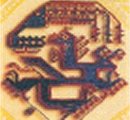 |
The Dragon is a mythological creature whose feet are like the lion's, whose tail is like a snake and who has wings. The dragon is the master of the air and water. The flight of the dragon and the Phoenix is believed to bring fertile rains of spring. The Dragon, believed to be a great serpent, is the guardion of treasures and secret objects as well as the tree of life.
|
|
| Eagle |
 |
Eagle figures symbolizing such elements as power, might, amulets, government heraldry and charm originating from old religious traditions can be observed as totems in
carpet-weaving.
|
|
| Earrings |
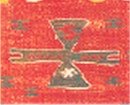 |
Earrings are indispensable as a wedding present in Anatolia. A girl using this motif is trying to inform her family that she wants to get married.
|
|
| Eye |
 |
It is believed that some people possess a power in their glance which causes harm, injury, misfortune and even death. The eye motifs were produced because of the belief that the human eye is the best protection against evil gazes.
|
|
| Fertility |
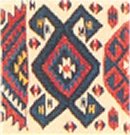 |
Hands on hips and ram's horn motifs used together denote a man and a woman. The fertility pattern is composed of two 'elibelinde' motifs indicating the female and two 'koçboynuzu' motifs indicating the male. The eye motif in the middle of composition is used to protect the family against the evil
eye.
|
|
| Fetter |
 |
It symbolizes the continuity of the family union, the devotion of the lovers and the hope that should always stay
together.
|
|
| Hand, Finger, and Comb |
 |
Hand, finger comb motifs including five points and five lines represents the belief that fingers are protection from the evil eye. Hand motifs combining productivity and good fortune also are a holy motive because it symbolizes the hand of the prophet Mohammed's sister. The comb motif is largely related with marriage and birth. It is used to express the desire for getting married and to protect birth and marriage against the evil eye.
|
|
| Hands
on hips |
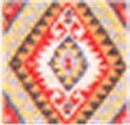 |
Hands
on hips is the symbol of motherhood, femininity and fertility.
|
|
| Hair Band |
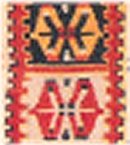 |
Hair Band motif indicates the desire to get married. If the woman uses some of her hair in weaving, she is trying to express her desire for immortality.
|
|
| Ram's Horn |
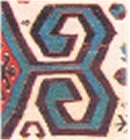 |
Ram's Horn represents productivity, heroism, power and masculinity in Turish carpets. Moreover it shows that the weaver is happy and it is the expression of this.
|
|
| Running water |
 |
Running water emphasizes the importance of water in human life.
|
|
| Scorpion |
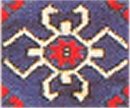 |
Due to their fear of its venom, people used to carry jewellery in the form of a scorpion or decorated with the tail of a scorpion in order to protect themselves against this animal. The scorpion motif is used for the same purpose.
|
|
| Star |
 |
The star motif in Turkish carpets expresses productivity.
|
|
| Tree of life |
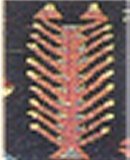 |
It is the symbol of eternity. The life tree represents the search for immortality and the hope of life after death.
|
|
| Wolf's mouth, wolf's track and monster's feet |
 |
People use these motifs as a means of protection against wolves and monsters. Since ancient times men have believed that they could control and protect themselves from dangerous animals by imitating them or by creating a similar form.
|
|